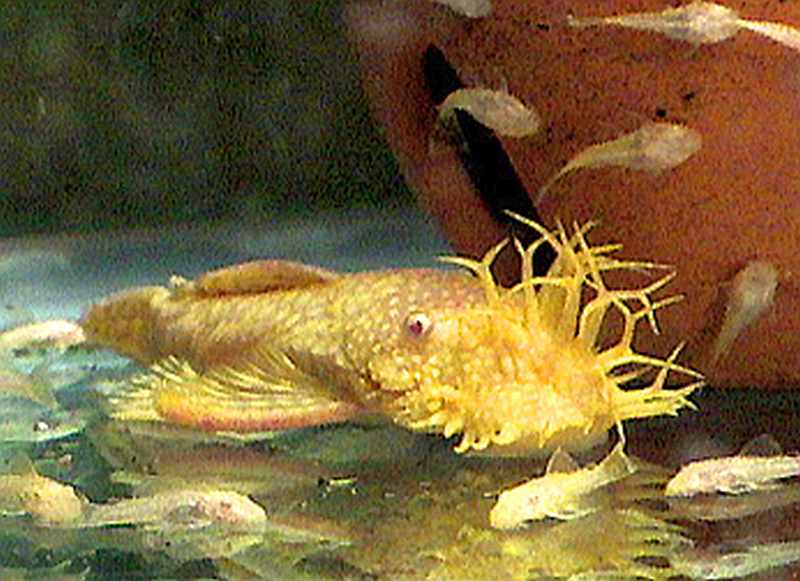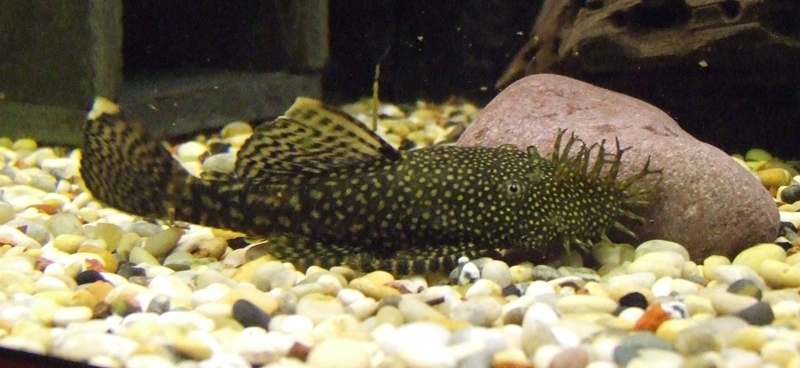
Bushynose Plecostomus With Young
The Bushy Nose Plecostomus (Ancistrus sp.), is found in the rivers and floodplain areas of the Amazon River Basin and elsewhere in tropical South America. Two species (A. centrolepis and A. chagresi) are found in Panama, and three species (A. cryptophthalmus, A. galani and A. formoso) are the only known loricariids that are true troglobites adapted to a wholely subterranean lifestyle.
The most commonly associated feature with the Bushy Nose Plecostomus are the fleshy tentacles found on the head of adult males. The mouth and nose areas (that give the fish its name) are covered in short, whisker like appendages, which like in other catfish are used for detecting food. Female Bushy Nose Plecos may possess tentacles along their snout margin but they are smaller. Females also lack having tentacles on their heads.
Except for the subterranean species which have reduced pigmentation, the Bushy Nose Plecostomus is mainly brown in color with a mottling of lighter colored areas on their bodies. Bushy Nose Plecos are found in many color and fin variations. The Orange Bushy Nose Pleco is a color variation that is mostly orange with dark brown to black markings. As they age, their “wiskers” will grow longer and their colors will darken.
The Albino Long Fin Pleco is found in the rivers and tributaries of Paraguay and has extremely long flowing fins. The Albino Gold Bushy Nose Pleco, a.k.a. Yellow-Ancistrus, comes from the Amazon River Basin of South America. Both of these Plecos are pale in color and like other albinos have red eyes.
Bushy Nose Plecos make great additions to any community aquarium. Bristlenose Plecos do not school but they usually hide when not feeding. They appreciate a well planted tank with some driftwood and caves to hide in. You can make them feel at home by surrounding them with Amazon Sword plants, Camboba, Hornwort, a few pieces of driftwood, and providing them with good water movement and heavy aeration. Because Bushy Nose Plecostomus seldom grow more than 6 ” in length, a tank size of 30 to 55 gallons is sufficient to house them.
The Bushy Nose Plecostomus is a relatively easy to feed omnivore. Most of their nourishment is obtained from grazing on algae and other surface growing organisms such as rotifers, small crustaceans, and protozoans. They will forage on left over fish food on the bottom of the tank and like other plecostomus, benefit from the addition of driftwood, which may be essential to their survival. In the absence of other plant matter in the aquarium, the wood helps with the digestion of high protein fish foods.
If no algae is present in the tank, feed them algae wafers or tablets, and supplement their diet with frozen bloodworms
, live blackworms, flake food, mashed peas, zucchini, spinach, cucumber, or other vegetables.
The Bushy Nose Plecostomus is easy to breed and is regularly bred in captivity by tropical fish keeping enthusiasts. In their natural habitat, breeding takes place in hollows, caves, and mud holes in the banks of creeks. The males clean the inside of the cavity with their suckermouth before letting the female approach and inspect the nest. Courtship includes expanding the dorsal and caudal fins and many attempts by the male to escort the female to the nest. The female can lay up to 200 adhesive eggs on the ceiling of the cavity or on a piece of driftwood in the aquarium. Males care for the eggs by cleaning them, removing diseased or infertile eggs, and keeping them aerated until hatching; which normally occurs in 4 to 10 days over a period of 2–6 hours.
The male will stand guard over the eggs for 7–10 days after they hatch. The fry remain attached to the walls and ceiling of the cave, or on the driftwood, by their mouths as they absorb their yolk sacs. In 2 to4 days the fry will be free swimming and should be moved to a separate aquarium. Feed them mashed peeled peas until they can eat algae on their own.
In the aquarium, breeding can be induced during the winter months by performing a major (70% – 80%) water change.
Bushy Nose Plecostomus are available for purchase in all color varieties at about 1 1/2″ to 2″ in length.

Bushy Nose Plecostomus (Ancistrus sp.)
Minimum Tank Size: 30 gallons
Care Level: Easy
Temperament: Peaceful
Aquarium Hardiness: Hardy
Water Conditions: 74-79° F, KH 6-10, pH 6.5-7.4
Max. Size: 6″
Color Form: Orange, Tan, White
Diet: Omnivore
Compatibility: Good community tank fish
Origin: South America
Family: Loricariidae
Life Span:
Aquarist Experience Level: Beginner


